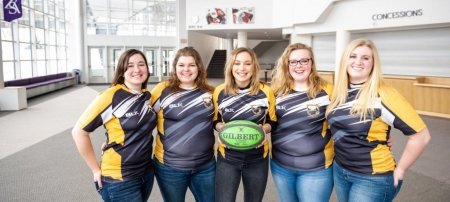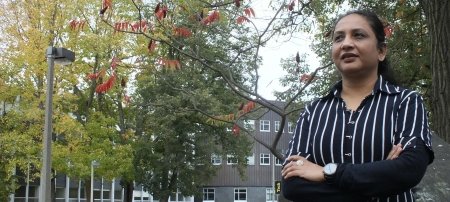With 31,700 square miles of sweetwater sea at our doorstep, sailing and Michigan Tech go together like snow and the Keweenaw Peninsula.
The sailors of Michigan Tech represent every aspect of the University, every nuance of the sport. Among students, faculty, staff, and alumni are designers, navigators, racers, and cruisers. Long-distance voyagers and day-trippers. New swabbies and salty dogs.
Huskies at the Helm
First on deck, our most visible mariner: Stephen Roblee ’75 ’80, a math professor for 33 years before he became primary captain of the 36-foot, 19-passenger Michigan Tech Research Vessel Agassiz. Steve’s sailed all over the world and spent entire summers plying the waters off Bayfield, Wisconsin, Lake Superior’s most populated sailing grounds.
Great Lakes Research Center Director Guy Meadows spends most of his water time aboard power boats. But he's also a sailor. Hard-core proof: footage of trying to outrun a South Pacific typhoon near Tahiti. He earned his US Coast Guard 100-ton license for power and sail, a seal of approval for carrying unrestricted numbers of passengers.
Like many Michigan Tech students, Guy's long sailing history begins with little Sunfish and Hobie Cats—light, beach-launched, personal-size sailing dinghies—before he moving on to something bigger: a 36-foot ketch-rigged sailboat. It's an arc familiar to the sailing mentors of Michigan Tech—one they hope to extend in the new sailors they welcome aboard.
"We have such a wonderful environment for sailing, it would almost be criminal to ignore it."
Sailors Without Borders
There's lots of university-community crossover. The Onigaming Yacht Club roster is full of mtu.edu addresses. Established in 1894 by the scions of Houghton—with names like Shelden, Douglas, Jacker, Calverly and Dee—the elegant supper club and docks on Portage Lake were sold years ago. All that remains is the Onigaming marker (Onigam means "portage") on the race course, just down from the former Sunshine Beach marker. The wreck of the yacht club's bygone flagship, the 120-foot coal-powered Sea Fox, lies against the Ripley shore opposite campus, near the black stampsand shores where many modern-day members keep their boats.

Yacht club is a misnomer for these down-to-earth mariners, many of them Huskies who simply love to race and cruise on Lake Superior.
On the 35-foot Hunter sailboat Nimbus Too, Dianne and Nancy Byers-Sprague share their love of sailing with Michigan Tech students, faculty, staff, alumni, and family from all over the world.
Nancy, director of graduate degree services, has compiled a 300-to-400-member crew list. While not all have made it aboard, it's safe to say the couple has taught sailing basics to hundreds.
Her email signature has something to do with it:
ASK ABOUT sailing with me in the beautiful Keweenaw of the Upper Peninsula
The Michigan Tech Sailing Club has about 30 members. It's open to students, faculty, and community. But only undergrads can race under Midwest Collegiate Sailing Association rules. Twice weekly practices begin after K-Day in early September and end in early November. The fleet of six Collegiate 420s, a 470, and two Lasers, are launched at Houghton's east waterfront park.
Club advisor Dieter Wolfgang Adolphs, associate professor of German language and literature, inherited the job from former advisor Ralph Hodek, an associate professor of civil and environmental engineering. Huskies often crew on Hodek's 40-foot Santa Cruz Red Hawk. She's a regular on the summer circuit, from the Bayfield Regatta to the Chicago Yacht Club Race to Mackinac. The 333-mile Chicago Mac this year celebrated its 107th run up Lake Michigan.
"It's important for Michigan Tech to have clubs like this," says Dieter. "It's important for students to have their identity. They're proud to be part of a team."
Dieter says many members are experienced racers, although anyone is welcome to try sailing (after passing a swimming test) before paying dues. Students also pay a per-race fee, driving long distances to compete in Midwest regattas.
Ralph bought the club some new sails. Additional help would allow the team to host racing events here.
"We can't host races without equipment."
Dieter also takes student crews on yacht club speed and distance races aboard his 30-year-old, 28-foot Laser Dark Star. Cam McNamara, who earned his bachelor’s in materials science and engineering in 2011 and returns from Australia to defend his PhD dissertation this winter, first sailed on Dark Star in 2009. “I was hooked. I enjoyed the hard yet technical work and wasn’t hesitant about handling the boat or going forward on the deck in difficult weather, so eventually Dieter put me on foredeck,” he says.

“In a technical sense, sailing has given me personal experience with fluid dynamics, weather patterns, and rigging systems. Both aerodynamics and hydrodynamics are important in racing. Understanding the loading that results from moving through these fluids dictates how the rigging should be tensioned or eased, and what material should be installed in the first place to handle the abuse. Psychologically, it has made me a better scientist by teaching me how to adapt—how to read the conditions that I’m working in and use them to get where I need to go—which is not necessarily a straight line. There are always wind shifts and sometimes it’s impossible to travel straight upwind at your goal. Philosophically, it has taught me self-reliance and fostered a deep appreciation of the natural world.”
"This summer was my first solo sail on Dark Star. The experience of sailing alone was invaluable because for the first time I felt like there was nothing tying me down to one spot and what's even nicer was the broken dependence on fossil fuels which is so ingrained in us. There is an enormous sense of freedom and wonder and, for me, a deep reverence for nature which only encourages me to do more experiments, explore more places, sail more water."
"'First Mate s/v Dark Star' is included on my résumé."
Harnessing the Wind
Spring 2016 graduate Rohit Sunil Pandhare, who earned his master's in mechanical engineering and plans to return for his PhD, is a new sailor. He's been crewing on Nimbus since the first week in July. "I love the idea that we’re using the wind to move the boat, nothing other than that, and as an engineer it just amazes me to see fluid dynamics in action."

Rohit likes to heel. That's when the boat tips, leaning far to one side, under the influence of the wind on the sails, the weight of the boat, and other factors. It often freaks people out because it feels like the boat will tip over. The physics of the scenario make that highly unlikely. The farther a boat heels, the less pressure there is because the sails present a smaller area to the wind. The ballast of the keel, located below the waterline, compensates with a righting motion.
"Heeling is exciting. Normally you do not want or expect a boat to bend in the water, but with a sailboat you want it to heel for optimal performance," Rohit explains. "Nimbus does the best at around 15 degrees."
"In theory sailing involves a lot of Laminar flows (or the quest to keep the wind flow between the jib and the mainsail as laminar), pressure difference between the sides of the sails, etc. —basic natural principles used in a way to make this thing do what we want it to."
"Engineering in action right here."
Off to the Races

The yacht club has summer Sundowner and fall Frostbite series along with some longer fun cruises and distance races. Nimbus Too often sacrifices any chance of winning by weighing the boat down with extra, untrained crew. "Light thoughts," cautions Dianne, as sailors from India, Ethiopia, and lower Michigan pile on. Snacks, sunblock, sailing gloves, and safety instructions are efficiently dispensed as Nimbus Too heads to the Portage Lake race course. Stay on the boat. If you drop something in the water, you won't get it back. If anyone falls in the water, point where they fell and keep pointing until they're back in the boat.
And basic nautical lingo: You can remember that port is left because it has the same amount of letters. Starboard is right. The bow is the front of the boat. The stern is the back. Ropes are 'lines' and sails are 'sheets.' Winches are 'grinders.'
And most important, a warning to duck when the boat turns, or "comes about," a maneuver that sends the boom swinging across the deck.
"Stand by to jibe. Ready? Helms a'lee." Dianne, a retired professor of mechanical engineering technology who's been plying these waters since 1979, waits a beat before smoothly executing the maneuver that sends the boom swinging across the deck.
"They call it the boom because that's the sound it makes when it hits your head."
With patient coaching crew members gain teamwork skills and an innate sense of balance.
There are terse commands for serious infringements, like when a student leans against the engine throttle. Dianne doesn't have time to sugar-coat it. "Move!"
The edge is taken off with post-race dark chocolate. Load distribution ceases to matter. No need for everyone to sit on one side of the boat. Time for the Titanic selfies that newbies can't resist.
Dieter's approach is less easy-breezy, but with identical intent. "We need younger people in their 20s, 30s, and 40s," he says. "I have hooked many students on sailing. I'm proud that I got them hooked."
"That's my favorite thing, too," says Nancy.
"I'm most proud when they get their own sailboats."

No one takes racing too seriously. "We're not like some racers. We don't get mad. We do play by the rules, but we're low key," says physics professor David Nitz, skipper of the aptly 28-foot Tartan named Gamma Hunter ("I study cosmic rays, and I'm always looking for the sunshine," he says). Like other mentors, he hopes sailors who crew with him gain the skills needed to sail for a lifetime.
"It's a sport you can enjoy until you're quite ripe. People sail into their 80s," says the teacher-mariner, who's spending his 25th season sailing Gamma Hunter, which had modified during her building to include central diesel heat. Sail handling is eased with a smaller jib (the triangular sail at the front of the boat). It takes less energy to make the boat "tack," or turn.
The most beneficial thing about sailing? "You have to think a lot," he says.
"It's a challenge and I learn something every week. David Nitzis an awesome skipper. I took up sailing in 2002 after getting very homesick in Windsor, Ontario and being told the best cure was to get involved in something totally new that I could never to back home in Northern Alberta. So I put my name on the boards at the yacht club and the sailing club and joined the crew of Chinook. I sailed with them until I moved up here in 2007."
Ahoy, Alumni!
Mike DeLano ’85 a self-described ME who often does EE work, crews on the 70-foot Santa Cruz Stripes for legendary skipper Bill Martin, former US Sailing Association President and University of Michigan Athletic Director. The always affable Bill, a Copper Country regular, describes Mike as his navigator. Mike clarifies “I trim the main. I’m a trimmer first and a navigator second.”
Mike was always a boater but didn’t start sailing until after Michigan Tech. He got interested in the details of racing and navigating and learned by reading. A lot. He carried around flashcards to memorize terms and concepts.
“It’s like engineering, right? You gotta do your homework.”
"Sailing is a semi-athletic chess match overseen by God."
Navigating over longer distances, like the Chicago Mac or the biannual Trans Superior isn’t difficult. The fascinating piece of the navigation puzzle is nature's variable. “You have to figure out what the weather is doing. These days you should at least know what’s coming,” says Mike, who has both west coast and east coast experience as well running the iconic races of the Great Lakes.
Back in Port
Some Huskies venture far afield and then return to help fellow Huskies and the surrounding community, like '66 Alumnus Bill Binroth. He and wife Nancy left the US in 1997, just 13 years behind their plan, he jokes, and completed the passage to and from Venezuela in stages aboard their 46-foot center cockpit ketch Skagerrak II, returning in 2000.

They relied on the classic The Gentleman's Guide to Passages South, a cruising guide that shows sailors how to comfortably navigate what is known as "the thorny path"—from the East US coast to the Virgin Islands—because it goes against prevailing tradewinds. The Binroths left from Fort Lauderdale, Florida, sailed through the Bahamas, Turks and Caicos, and to Hispaniola. Next came Puerto Rico, then the Leeward and Windward Islands. On to Grenada, Trinidad and Isla Margarita, Venezuela. In Monserrat they were perplexed by Do Not Anchor signs, not realizing the Soufriere Hills Volcano had erupted, covering the island in ash and making most of it uninhabitable. They had to sail all night to reach safe harbor.
The Binroths recently resettled here. Nancy's from Chassell. They've downsized to the original Skagerrak, a 1976 26-foot sloop. But the couple is still leaving a big wake.
You can't sail the world and not be changed by conditions you witness, says Bill. The philanthropists are making waves with Let's Eat campus-community dinners on the fourth Sunday of every month.
The meal is free, thanks to local sponsors. That's not the point, though. By land or sea, the sailing life is as much about camaraderie as competition.
Image Gallery
Michigan Technological University is an R1 public research university founded in 1885 in Houghton, and is home to nearly 7,500 students from more than 60 countries around the world. Consistently ranked among the best universities in the country for return on investment, Michigan's flagship technological university offers more than 120 undergraduate and graduate degree programs in science and technology, engineering, computing, forestry, business, health professions, humanities, mathematics, social sciences, and the arts. The rural campus is situated just miles from Lake Superior in Michigan's Upper Peninsula, offering year-round opportunities for outdoor adventure.







